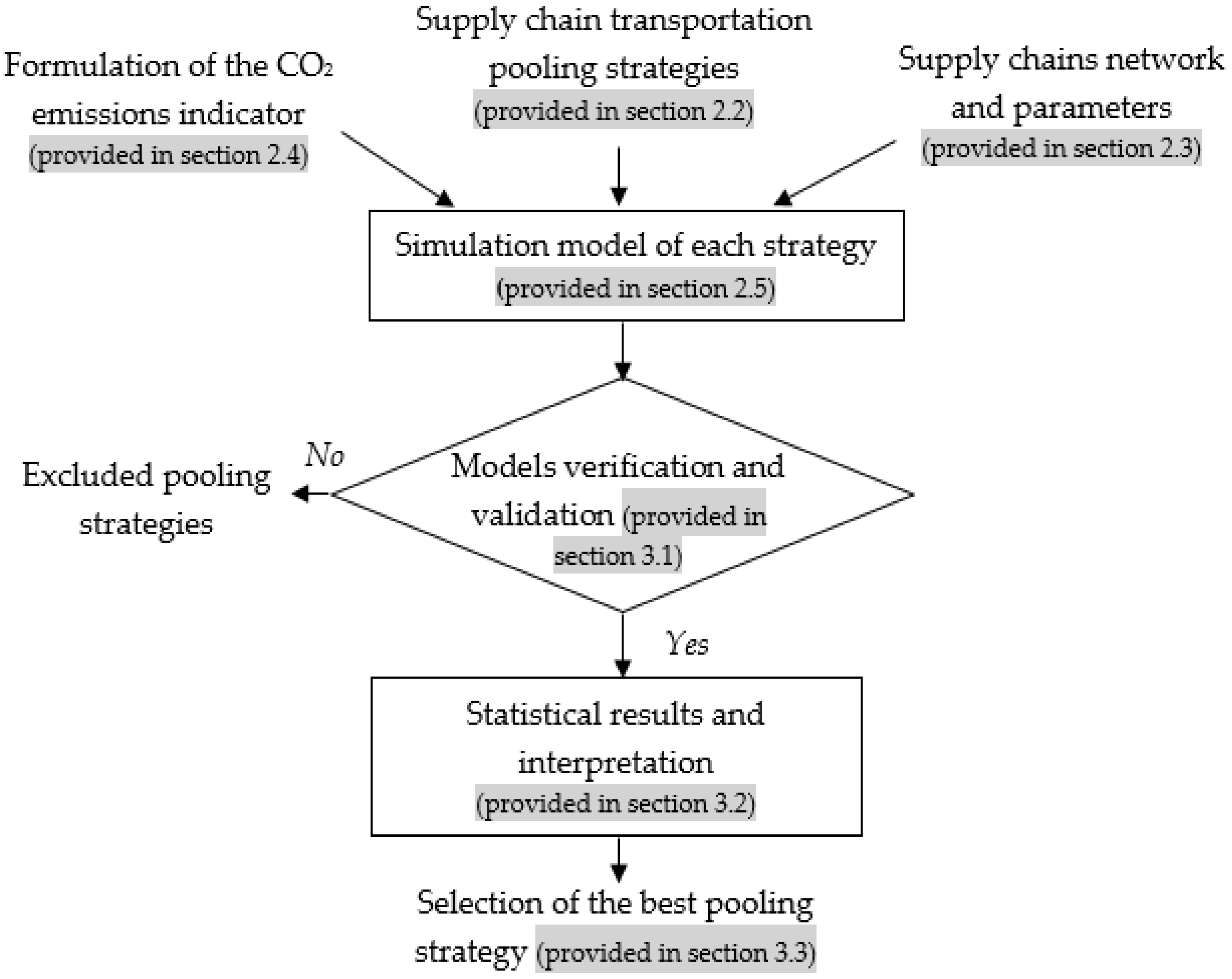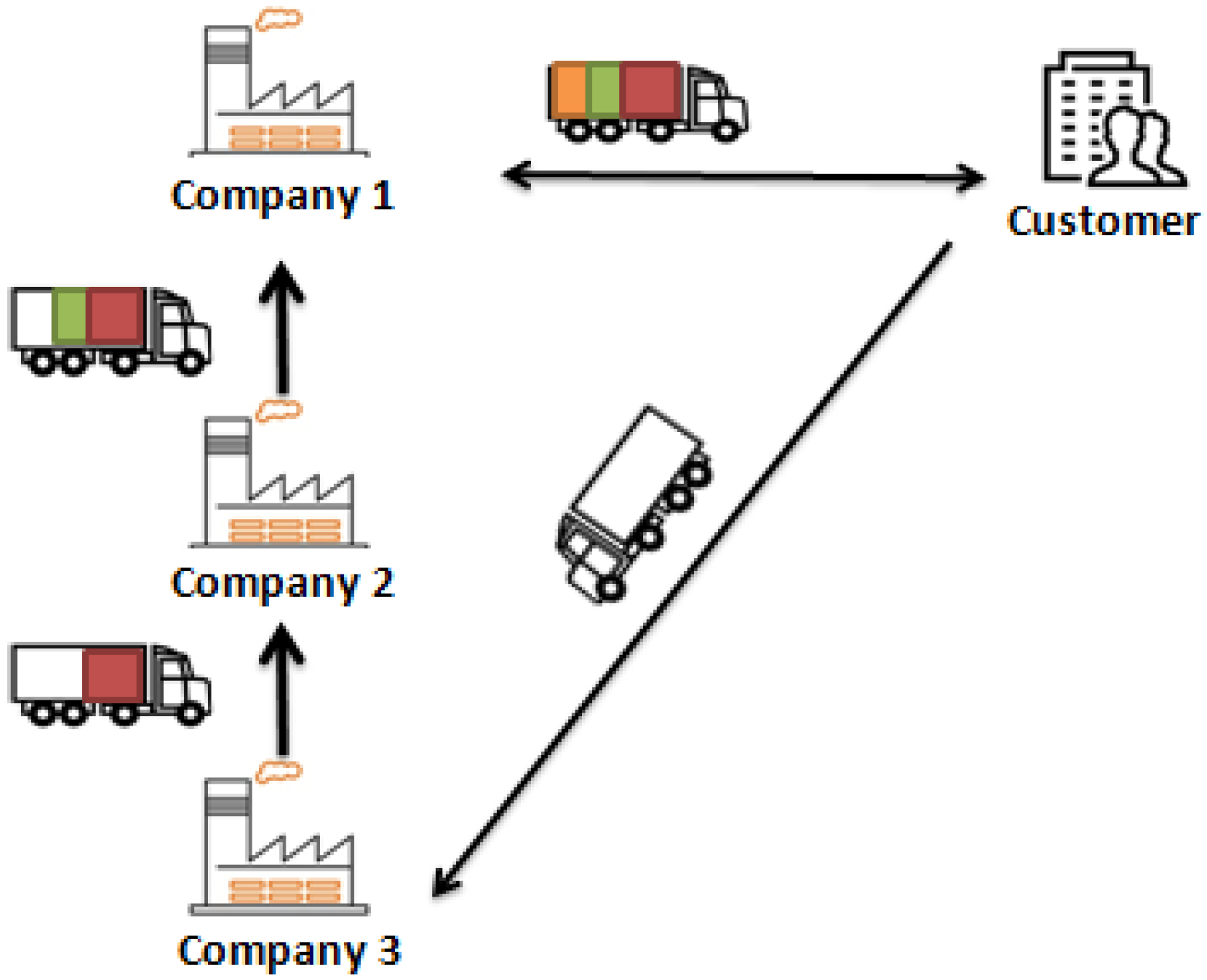Supply chain transportation pooling strategy (SCTPS) is one of the innovative supply chain collaboration strategies. This concept goes much further than the simple idea of grouping vehicles, which is quite common in the professional world. It is essentially based on a partnership agreement that consists of voluntarily pooling and sharing resources (infrastructure, vehicles, etc.) and information from several supply chains with the aim of achieving a particular level of performance or gains [
4]. Initially, the only opportunities perceived by supply chain managers in the concept of logistics resource pooling were purely economic. However, new and stricter ecology legislation has led them to consider the concept of combining logistics resources for environmental purposes, such as reducing CO
2 emissions [
5,
6].
1.1. Literature Overview
One of the main concepts for improving the sustainability of supply chains is the collaboration between stakeholders by increasing the efficiency of their shared resources [
7,
8,
9,
10]. There are two types of collaboration: vertical collaboration and horizontal collaboration. Vertical collaboration involves cooperation between stakeholders in the same supply chain, while horizontal collaboration includes cooperation between companies at the same level that can provide the same goods or services within a supply chain [
11,
12]. In the literature, there is a large amount of research related to vertical collaboration in the logistics industry [
9,
10,
11]. However, horizontal collaboration such as shared freight carrier and freight consolidation has not received the same degree of attention [
7,
8,
13], etc.
Over time, the concept of pooling logistics has been increasingly developed in the literature. Several research works are in line with collaboration approaches. Tuzkaya and nüt [
14] addressed the problem of designing collaborative warehouses and transport networks through linear programming. The principal objective of their research was to determine the best strategy to distribute products from suppliers to a clustering hub and from this clustering hub to manufacturers. They looked at various constraints related to supplier and hub capacities, starting stock and backlog levels, transportation times, manufacturers’ demands, etc. The results of the linear programming model were compared for different scenarios. Further analyses were then performed by the authors to measure the sensitivity of the model results for different parameter values.
Ballot and Fontane [
13] used an already optimized supply chain of a French distribution chain to study the possibility of further improving its performance using the logistic pooling strategy. The objective of the authors was to reduce the environmental impact of the supply chain by reducing transport emissions. The authors estimated CO
2 emissions from different empirical models of supply-pooling network strategies. The results showed a reduction in CO
2 emissions of about 25% with the new organizations. Qiu and Huang [
15] study the pooling hub capacity across several supply chains using mathematical models and assess the impact of demand uncertainty on their financial performance measures. Two mathematical models were formulated for the studied supply chains. The first one does not consider the pooling hub, and the second one considers a pooling one. Therefore, the authors conducted different experiments to examine the clustering under different demand models and variances. The results show that the benefits of pooling hub capacity depend on the demand model. The results also indicate that demand variance can significantly influence the effect of central capacity pooling in terms of total supply chain costs. Leitner et al. [
16] designed a centralized supply chain for automotive suppliers in Romania and Spain to reduce the cost of supply, CO
2 emissions, and increase transportation efficiency. The results of this study showed that the grouping of transport operations by the different partners generated a significant reduction in the number of trips, fuel consumption, and CO
2 emissions, in addition to transport costs.
Moutaoukil et al. [
17] presented a pooling logistics model that takes into account the specificities of the agricultural and food supply chain flows. This model integrates the economic, environmental, and societal dimensions of the sustainable development objective. After identifying the different possible scenarios, the authors have shown the practical use of their proposal through the modeling of a particular scenario using a simulation technique to analyze the minimization of the total transport cost, the system’s CO
2 emissions, and the risk of accidents per million kilometers travelled by transporters. Pan et al. [
18] explored the effect of combining supply chains on their CO
2 emissions with road and rail transport. They developed an optimization model with a piecewise linear objective function to assess quantitatively the impact of the products’ flows pooling on supply chains CO
2 emission. This model was then tested with real data for 12 weeks in a large distribution network composed of the supply chains of two French retailers. The overall results show a 14% reduction in CO
2 emissions with road transport and 52% with joint road and rail transport. Montoya-Torres et al. [
19] conducted a case study through real data from the city of Bogotá, Colombia, for three companies in which each company has its own stores. They used mathematical modeling to compare the collaborative to the corresponding non-collaborative scenarios in terms of travel distance. In the non-collaborative scenario, each firm distributes goods to its own stores. While in the collaborative scenario the stores of the three companies are allocated to one of the three companies, serving as a pooling hub, and then routing is performed for each new allocation. On the basis of the obtained travel distances, the authors evaluated the travel time and carbon emission. The results highlight the quantitative benefits that can be obtained when pooling logistics operations are implemented, represented in both transportation costs and environmental impacts.
Ouhader and El kyal [
7] tried to quantify the potential environmental and economic benefits of horizontal collaboration in transportation. Therefore, they studied the sensitivity between CO
2 emissions and transportation costs through an approach based on bi-objective mathematical modeling to minimize both the total transportation cost and the total environmental effect by simultaneously combining the location and routing decisions of the facility in urban freight distribution. The results of a noncollaboration scenario with the corresponding collaboration one showed that collaboration leads to a reduction in CO
2 emissions, transport costs, and distances traveled, in addition to the improvement of the vehicle load rate.
Habibi et al. [
20] studied the problem of pooled hub location in the context of collaborative distribution network design in supply chains. The authors used two distribution networks of different supply chains to determine the best locations of the hubs that optimally serve their customers. Based on three collaborative cases and four cost-sharing strategies, the authors were able to verify whether collaboration offers a better decision and how to share the total cost between each supply chain to achieve a cost-effective solution.
Mrabti et al. [
21] proposed a generic model of a pooled supply chain using discrete events simulation to assess economic indicators such as logistics cost, vehicles filling rate, and the environmental indicators CO
2 emissions. The authors then addressed a case study to examine the performance of the pooled supply chain strategy. This strategy was shown to reduce logistics cost, improve vehicle fill rate, and reduce CO
2 emissions.
Zouari [
22] analyzed seven scenarios of logistic integration among a set of three companies in urban and interurban distribution. The main objective of this research was to choose the optimal path by showing the challenges and opportunities of pooling logistics. This resulted in reductions in transportation costs, congestion, and GHG emissions.
El Bouazzaoui et al. [
23] discussed the concepts of transport and storage pooling in the Moroccan hydrocarbon supply chain. They studied the environmental impact of the pooling of resources used by the consolidation of transport trucks and storage tanks on the reduction of CO
2 emissions from different trucks from two companies. Based on real data of petroleum product flows over seven years from two major importers before and after resources pooling simulation models were developed to determine CO
2 emissions variation rates. The simulation results showed about 46% of the minimization of CO
2 emissions.
Gallardo et al. [
24] applied an interdisciplinary transition innovation, management, and engineering methodology to the conceptualization, redesign, and redevelopment of the existing freight systems to achieve a downshift in CO
2 emissions.
In the literature, some research has studied CO
2 emission using simulation techniques in other areas. For instance, Sopha et al. [
25] developed an integrated approach based on agent-based modeling and DES to evaluate CO
2 emission to decide between the existing evacuation plan for the Mount Merapi volcano eruption. Li and Lei [
26] and Limsawasd and Athigakunagorn [
27] applied DES in estimating and analyzing CO
2 emission construction engineering projects.
Moreover, in the literature, collaboration in supply chain have two types of benefits: economic benefits and environmental aspects benefits. A recent example of research is Gansterer et al. [
9], which found that cost savings of 20–30% were made by carrier collaboration. The reduction in vehicle kilometers is demonstrated as a component of cost savings. However, Gansterer et al. [
9] have not quantified explicitly the CO
2 emissions and the environmental aspect is not considered. In other examples [
13,
14,
15,
16,
17,
18,
19,
20,
21,
22,
23,
24,
25,
26,
27,
28], the GHG emissions is explicitly studied as benefits of supply chain collaboration.
1.2. Objectives and Contributions of the Study
Based on the literature review, this research starts from two major assertions. First, the majority of previous research in supply chain transportation pooling strategy (SCTPS), which can also be named freight consolidation, have studied the impact of only one type of SCTPS on the supply chain performances. Second, most of the previous research is related to vertical collaboration in the supply chain and rarely to horizontal collaboration. To fil this gap, the present research is about analyzing the effect of various SCTPS to reduce CO2 emissions using discrete event simulation (DES). In fact, the studied problem of SCTPS design considers both vertical and horizontal collaboration.
The studied supply chain is a network between two manufacturing companies and three customers and its suppliers to produce and distribute four product types. Five SCPS are studied and include the following: (1) non-pooling strategy; (2) multi-pick strategy; (3) multi-drop strategy; (4) central hub strategy; and (5) combined hub and multi-drop strategy. For each studied strategy, a three-step approach is applied. First, a simulation model for the strategy is developed using Siman/Arena software. Second, the verification and validation of the simulation model are based on the Pearson correlation test between CO2 emissions and the mean delivery time of each customer and between the mean delivery time of each pair of customers. Third, one-way analysis of variance (ANOVA) and Games-Howell simultaneous confidence intervals are used to interpret simulation results. The main result of the study, which will be obtained in the end, is that all SCTPSs significantly reduce CO2 emissions compared to the non-pooled supply chain.



















